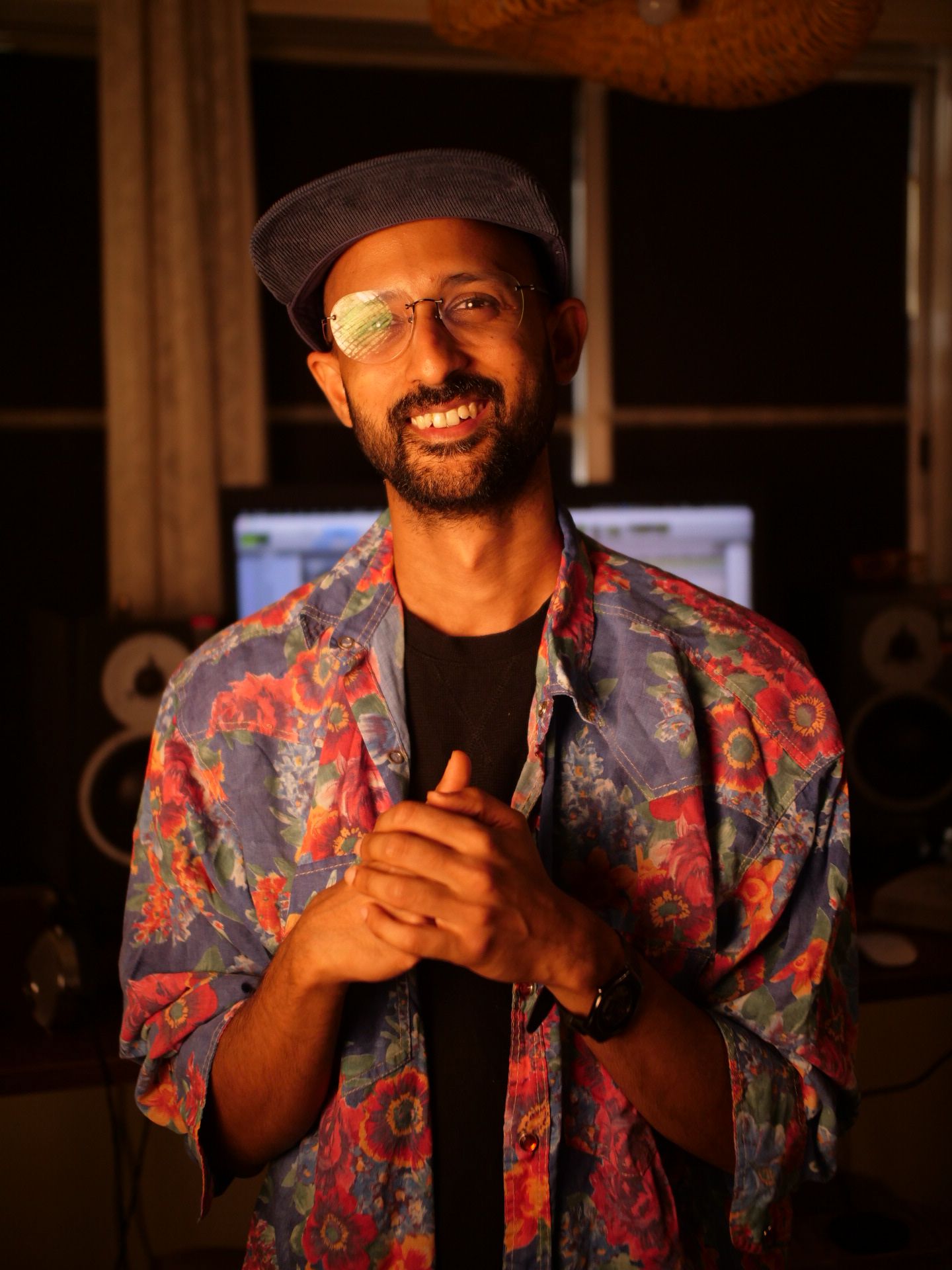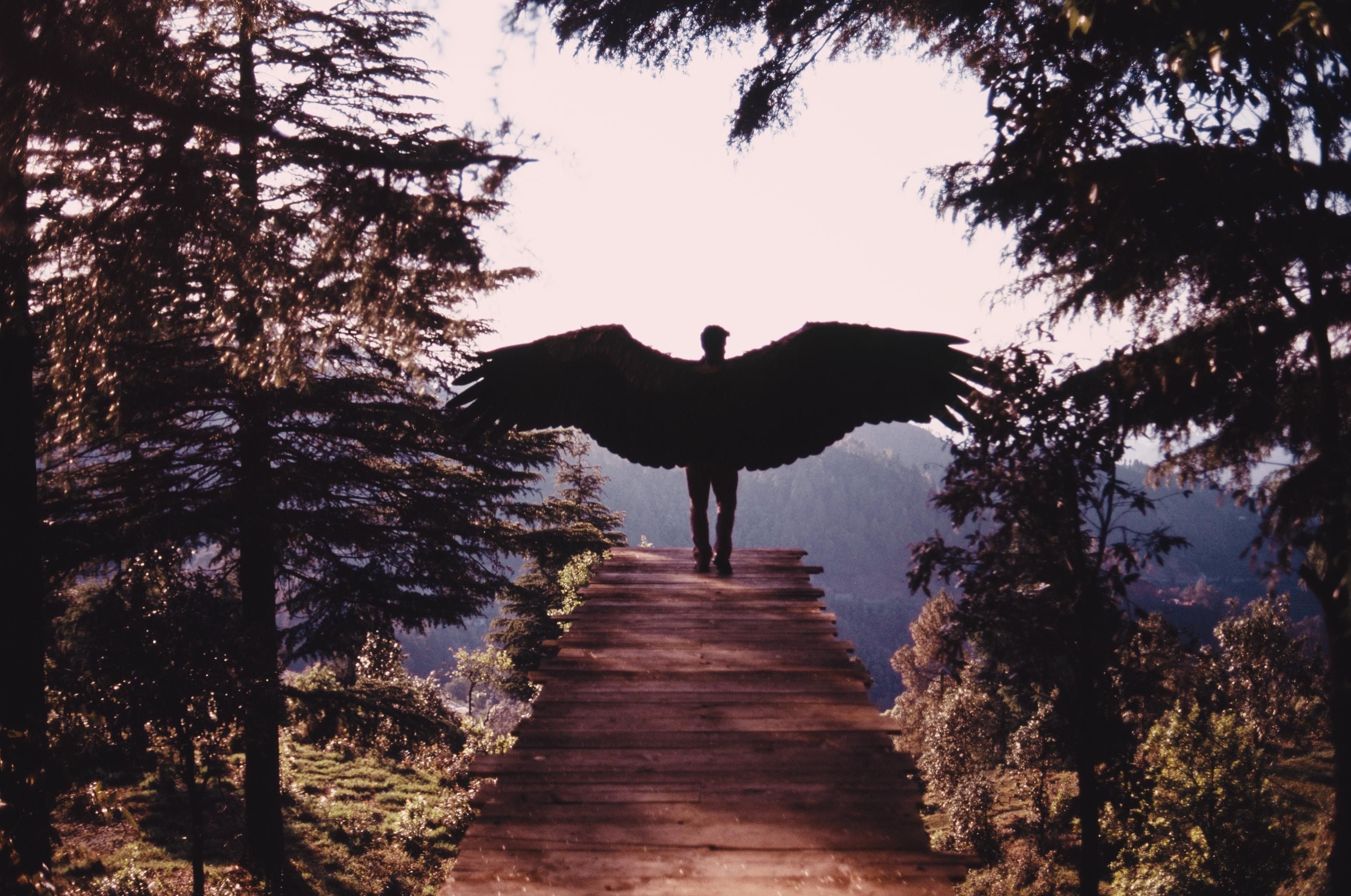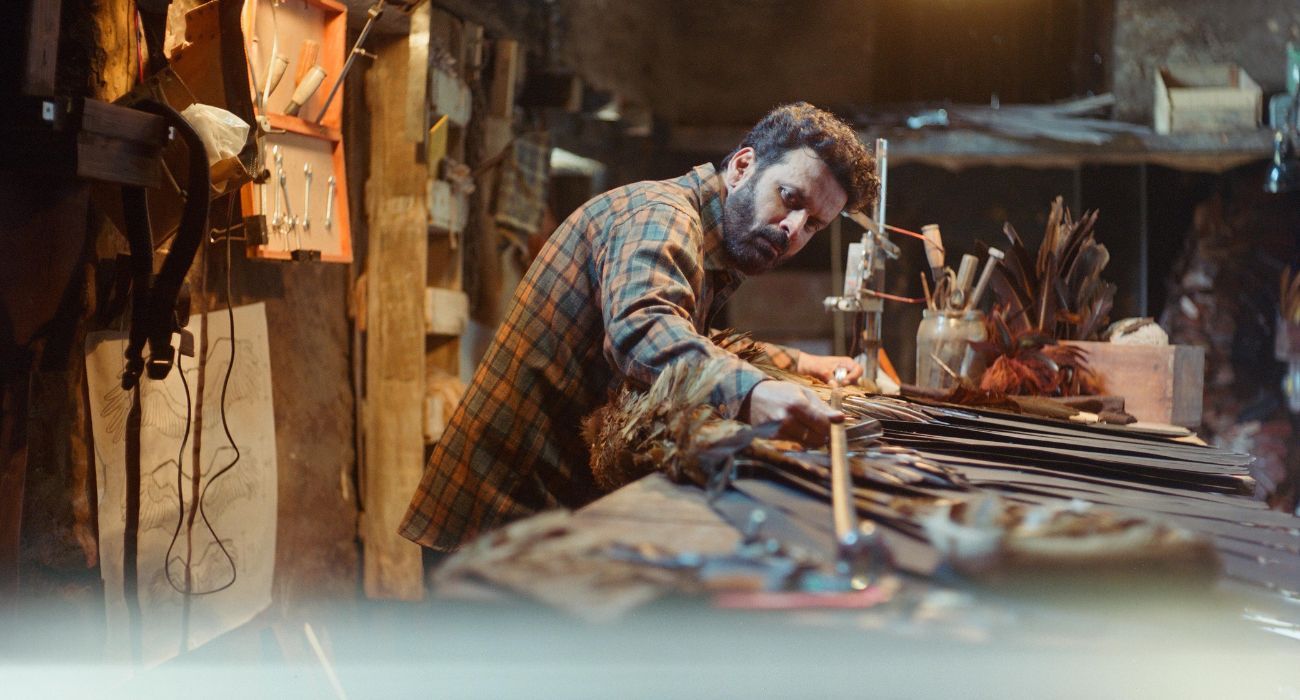Raam Reddy, who had made his directorial debut with the Kannada drama Thithi in 2015—the movie that premiered at the 68th Locarno International Film Festival picking up the e Golden Leopard in the Filmmakers of the Present category, and went on to win the National Film Award for Best Feature Film in Kannada—has just dropped his sophomore film after a decade. And this time he is experimenting with magic realism—Jugnuma: The Fable unfolds like some bedtime story told by your ageing grandma mixing half-forgotten folktales and myths with contemporary occurrences.
The year is 1989. Dev (Manoj Bajpayee) lives with his wife and two kids in a colonial-era bungalow located inside a sprawling Himalayan orchard that he has inherited from his ancestors who served the British. The orchard provides employment to the locals and their relationship with Dev and his family remains that of landlord and tenant. Even though there is discontent among the locals over Dev’s introduction of chemical pesticides in the area to extract high yields, which will have long-term negative consequences on the ecology of the area, they are fiercely loyal to Dev and even when later in the story he kicks them out of their jobs and withholds their salaries for no fault of their, they don’t protest. But then, not everyone is willing to be subservient to this erstwhile zamindar—simmering dissent ignite into solitary flickers of rebellion which soon spreads like forest fires, literally. As a mystified Dev vehemently tries to make sense the goings on and contain it, a thick fog of suspicion and mistrust settles over the valley. It is then the whodunit shift gear snapping its ties with the real and spreads its mechanical wings towards the magical.

Essentially a poetic yet poignant exploration of human hubris vs nature's resistance, along with environmental exploitation, it also deals with colonial inheritance, classism, and raises the pertinent contemporary question: who should a piece of land belong to…the legal owners who have inherited the property and using it to yield optimum profit or the indigenous people who have worked the land for generations creating a deep understanding and bond with it? Or is it Mother Nature—when human interference becomes too much, she rises to reclaim what is essentially hers?
Beautifully shot on 16mm celluloid film stock that gives the movie its distinct weather-beaten, nostalgia-steeped visual texture, Reddy seamlessly weaves in the VFX shots to create a bewitching impressionistic aesthetic. It trades conventional background score for a meditative and subtle ambient sound replete with rustling of dry leave, crackling of forest fire, rumbling of the stream, and the hush of silence. Mixed on a 64-channel Dolby Atmos system, the soundscape adds in creating the immersive experience that transports one to the Jugnuma world of horse nomads, fallen fairies, fireflies, mechanical wings—the world where the real meets the magical.
Starring Manoj Bajpayee—who gives another stunningly subtle performance, Deepak Dobriyal, Priyanka Bose and Tillotama Shome, Jugnuma is already making waves in the international festival circuit. After having its world premiere at the 74th Berlin International Film Festival in the prestigious Encounters segment and becoming only the second Indian film in the last 30 years to feature in a competitive section of the Berlinale, it went on to win the Best Film award at the 38th Leeds International Film Festival—the first Indian film to do so. We caught up with the director, whom many are now comparing to Guillermo del Toro—a master of magic realism. Excerpts
What is your relationship with magic realism? Do you think it is difficult to translate in cinema?
Magic realism is very challenging to translate in cinema and that was one of the core challenges I set for myself with this film. I have always been a big admirer of magic realism in literature and was always fascinated that it was considered a mainstream genre in literature with Murakami, Marquez, Salman Rushdie all being incredibly successful authors with massive fan bases. People allow their imaginations to interpret words freely, but to allow an audience to access their imagination via a film is more challenging and that’s what I was hoping to achieve with Jugnuma.
What are according to you some of instances in cinema that aces it? Can you pick a few favourites?
Emir Kusturica [two-time Palme d'Or winning Serbian filmmaker] is one of my favourite filmmakers. His films like Time Of The Gypsies and When Father Was Away On Business are amazing. Lee Chang-dong’s [South Korean filmmaker] works like Burning and Oasis are also magic realism masterpieces. And then we have Miyazaki’s [Hayao Miyazaki, Japanese filmmaker and co-founded Studio Ghibli] entire filmography.
What is the most memorable reaction you have received for the movie so far?
The most memorable reaction was also the very first reaction—during my first Q&A after the world premiere in Berlin a lady said she has been coming to Berlinale for a decade, and that this was the best film she has ever seen at the festival.
How were the international screenings? Do you think there is a fresh interest for Indian cinema at the festival circuit? Have we gotten better at taking our films to these festivals?
The international screenings were all incredible. Many people got emotional after watching the film; I saw a sparkle in their eyes. The Jury Statement from the Best Film Award at the Leeds Film Festival really moved me.
There has always been interest in Indian films in the festival circuit. But there are more films now that are breaking out and becoming well known via the festival circuit.

Your sophomore film has come after a decade. Has this anything to do with the pressure created by a National Award-winning debut? When did you start working on Jugnuma?
This film was a dream that took a long time to materialise into what is now on screen. There were many gaps where we were waiting on things to align. It was an uncompromised project where quality was paramount. The pandemic added years to that struggle.
More than pressure, when the first film does well, it’s a huge encouragement. That’s what gave me the courage to dream big with Jugnuma. Of course, after writing it, when it comes to execution, there is a lot of pressure one puts on themselves to try and top the quality of work they’ve done in the past. I felt this internal pressure continuously, but it was also a big motivator.
What was the starting point of this movie?
The starting point was three things: I wanted the film to suspense driven, I wanted it to have magical elements, and I wanted to set it in the mountains. With this intention I took a trip to the mountains. While there, there was a sudden crisis of a real forest fire, which I went to fight with the locals. It was in this experience that the narrative seed was born.
Was there a real fable that inspired this?
The fable itself is fictional, but draws heavily on the kind of folklore that is so endemic to Indian history and traditions. It was designed to feel like a universal bedtime story to lull us into hope and comfort.
Like your previous movie, this also has a distinct documentary feel to it. Why did you pick this particular treatment and visual style for a movie that deals with magic realism?
The second half of magic realism is realism itself and that gives the magical elements a heightened sense of wonder. It becomes hard to decipher truth from fiction, which helps the fictional elements grasp the audience while trying to maintain the willing suspension of disbelief.
Also, the visual style reminded me of Iranian cinema. Was it intentional?
I have been inspired by Iranian cinema as a film student—the honesty, the lack of fear of being observational, the lack of fear of silences, all while maintaining a strong emotional hold on the audience—it is these beautiful factors that set Iranian cinema, and a lot of the great world cinema, apart.

Can you take us through the soundscape of the movie which makes stunning use of sounds of nature and silences?
This too is an aspect of that unwavering commitment to realism. I wanted the audience to feel like they have travelled to that world…it should feel like you experienced it firsthand with the characters. Night had to not only look like night but also sound and feel like night. I find sound design to be the spiritual core of cinema as a craft and find that it is just as effective as music in creating emotion, if designed carefully and with intention.
Tell us about the casting of Manoj Bajpayee. His performance was crucial in creating the right impact and tone. Was the character written with an actor in mind?
No, I didn’t write with an actor in mind, but after I finished the screenplay, it was very clear to me that no one would be more perfect as Dev than him. He has immense control over his craft—for a soft-spoken character like Dev with a very particular aura and internal journey, Manoj ji was the quintessential actor for the part. Not only had he played iconic and often violent roles like Sardar Khan in GOW, he had also had played very gentle and moving roles like his performance in Aligarh.
How did you approach Bajpayee and what was his initial reaction? What did he bring to the table?
I reached out via my amazing casting director Tess Joseph who sent him the script. After reading the script, he immediately asked for a meeting and agreed right away. The collaboration was beautiful and often effortless. He just got Dev on the deepest level. Our job as an actor-director team then on was more surface level things—like working on Dev’s voice, pacing etc.
He quite simply became the soul of the film and brought an incredible depth and dignity to
Dev. Even with all the challenges that the character has to face throughout the film, he slipped into those shoes and just merged into the world.
Tell us about the challenges of working with non-actors. Why did you opt for them? How did you select them?
I love working with non-actors too. My first film Thithi was only non-actors. Non-actors bring their entire past and their own very specific personality and history in their portrayal of a are in essence playing themselves, they are the most nuanced—they can’t hide who they are, and that leads to very unique characters on screen.
I selected them with the help of my location casting director, Gurpal Singh. We actually went into the villages searching for people who were interested and would fit the roles in the script. You can’t expect non-actors to come to you. You have to go to them!

Can you also elaborate on the casting of Tillotama as a villager amid the non-actors?
Tillotama’s role was so key to the entire story; her scenes were in essence the soul of the narrative. I knew I needed an actor with the utmost ability to transform and perfect control to hit the right tone and emotion in her storytelling. It was a really challenging scene that needed a very complex balance and a nuanced soulful delivery that was at the same time natural because in the story she is just trying to put her fearful son to sleep. And I thought she did it so much more beautifully than I had imagined when writing it.
Tell us about the wings…unlike going the Birdman way, why did you opt for the real wings? Also, you don’t show any real purpose of those real wings…
That was exactly the point! I was very keen to keep his obsession with wings and flight observational and completely unadorned—just like a morning walk or sipping a cup of tea. There was nothing great about it, it just is. For Dev as well, it is just another piece of his reality. That treatment for me is at the very core of my magic realism. That treatment was completely intentional.
It is not an easy film, do you think you stayed pure and true to the director’s vision all through it?
Absolutely. The film was made with an uncompromising honesty in every frame and an unwavering commitment to the original vision. Not a single tweak was made thinking of the audience; I respect the audience too much to try and manipulate them that way. I prefer to offer whatever is in my heart, telling a story in the most authentic way I can, and hope they enjoy it!
How difficult it is to make and release a film like this in India today?
It is challenging to release a film like this surely because it is different stylistically from other films in Bollywood. But it is now in theatres and growing steadily so I guess there is big audience out there that want to engage with such work - the challenge is in reaching them and making them aware of the film.
Do you think there is a need for a platform dedicated to showcase experimental movies meant for a niche audience?
The film is my undiluted vision. I may at some point in the future release some of the deleted scenes, as many of them also were of high cinematic quality with beautiful performances. Plus, I personally love watching deleted scenes from films like The Godfather and other classic films.






